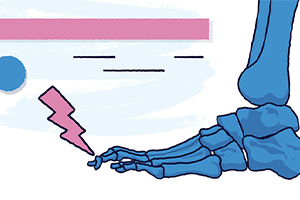Mallet toe is a type of deformity in the toe joint that can cause pain, discomfort, and restricted movement.
If diagnosed early, the condition can be easily managed.
In this post, we’ll take a look at what causes mallet toe and how it can be treated.
What is mallet toe?
Mallet toe is a condition where the joint towards the tip of the toe becomes bent, making it look curled instead of flat. It usually occurs in the second toe. However, it can affect any of the four smaller toes.
Mallet toes are often confused with claw toes, but although both cause toe deformities, they are different conditions. With claw toes, two or three of the joints are usually affected, giving toes a claw-like appearance, while mallet toes only affect one toe joint.

What causes mallet toe?
Mallet toes are often caused by an imbalance in the muscles, tendons or ligaments that usually hold the toe straight. However, other factors can also cause the condition, such as ill-fitting, tight shoes, your specific foot structure, trauma, and even certain diseases, such as arthritis, diabetes, and some neuromuscular conditions.
Other risk factors that can increase the chances of developing mallet toe include:
- Age - Chances increase as you get older
- Sex - Women are more likely to develop mallet toe than men
- Toe length – You’re more likely to develop mallet toe if your second toe is longer than your big toe
Mallet toe symptoms
The main symptom of mallet toe is when the joint at the tip of your toe becomes bent and appears curled rather than flat.
You may also notice calluses, corns, or blisters appearing where your toe rubs on your shoe when walking.
As the condition progresses, you may also experience pain and swelling.
How is mallet toe treated?
Various mallet toe treatment options are available depending on the severity of the condition. In most cases, there are things you can do at home to help correct mallet toe and find relief. These can include:
- Over-the-counter medications to help relieve pain
- Wearing footwear that has more room in the toe area
- Using a toe splint to help keep your toes in the correct position
- Stretching out your toes frequently
- Physical exercises to strengthen your toes
- Using orthotics (special shoe inserts) to help take pressure off the affected toe
Mallet toe surgery
In some cases, you may require surgical treatment for your mallet toe. Different types of procedures can be carried out, depending on the severity of your condition. These include:
- Arthroplasty – This is where part of the bent toe is removed and realigned
- Tendon release – This involves cutting a tight tendon to help the toe lay flat
- Tendon transfer – This is where the tendon in the mallet toe is moved to another part of the foot, which helps the toe straighten out
- Joint fusion – Small surgical wires or screws may be inserted across the affected joint to hold the toe in the correct position
The type of surgery and how long it will take depends on the severity of your condition, however, mallet toe surgery is usually an outpatient procedure, and you should be able to return home the same day.
Costs for this type of surgery will vary depending on the procedure you need. At Ramsay Health Care, we offer a range of payment options, including a Total Care package that gives you direct access to all treatment and aftercare support for a one-off payment. We also offer 0% interest payment plans to help you spread the cost.
Recovery from mallet toe surgery
After mallet toe surgery, you may need to wear a special boot or use crutches to mobilise. You will need to avoid putting any weight on your foot following surgery, and you will need to keep your foot elevated as much as possible to reduce swelling.
Your surgeon can prescribe you pain-relieving medication to help reduce any discomfort.
You will need to take a few weeks off work and may need help with day-to-day household tasks.
You will also be advised when it is safe to undertake exercises to regain your mobility, and if you’ve had a wire inserted, you’ll be informed of when this will be taken out.
It can take up to six weeks before you can properly stand or walk for long periods. However, swelling can take up to six months or more to go down completely.
Mallet toe treatment at Ramsay Health Care
Here at Ramsay Health Care, our hospitals offer the highest quality surgical care for problems of the small toes. Our foot surgeons and supporting care teams regularly see patients with foot complications and understand the pain and discomfort they can bring.
We aim to offer the best treatment option for your foot problem as quickly as possible. If surgery is required, rest assured that you’ll be in our orthopaedic surgeons' safe and experienced hands.
You’ll also receive full rehabilitation support from our aftercare team.
Contact our team to find out more or to arrange a consultation.